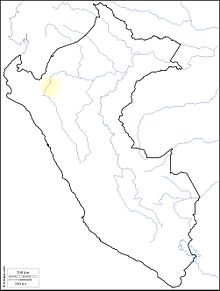Excidobates mysteriosus
The Marañón poison frog (Excidobates mysteriosus) is a frog. It lives in Peru.[2][3][1]
| Excidobates mysteriosus | |
|---|---|

| |
| Scientific classification | |
| Domain: | Eukaryota |
| Kingdom: | Animalia |
| Phylum: | Chordata |
| Class: | Amphibia |
| Order: | Anura |
| Family: | Dendrobatidae |
| Genus: | Excidobates |
| Species: | E. mysteriosus
|
| Binomial name | |
| Excidobates mysteriosus (Myers, 1982)
| |

| |
| Synonyms[2] | |
| |
Body
changeThe adult frog is about 27-29 mm long from nose to rear end. The skin of the frog's back is black with big white dots. There is always a dot under the chin.[3]
Home
changeThis frog is awake during the day. It lives in forests that have never been cut down that have spiny plants and bromeliad plants on the ground. They live near cliffs and look for food in small plants. Scientists have seen adult frogs and young frogs eating ants and flies. People have seen this frog between 600 and 1305 meters above sea level.[1]
Young
changeThese frogs only have young in the pools of water in bromeliad plants because there is not enough water anywhere else in the dry part of the year. The female frog lays the eggs on one part of the bromeliad plant. After the eggs hatch, the male frog carries the tadpoles to other pools in bromeliad plants. The bromeliad plants that the frogs need only grow on very old trees.[1][3]
The tadpoles are black in color.[3]
Danger
changeScientists say these frogs are in danger of dying out. These frogs only live in a few small places. In the 1990s, people used to catch this frog to sell as a pet. Scientists say this might still be a danger to this frog.[1][3]
References
change- ↑ 1.0 1.1 1.2 1.3 1.4 IUCN SSC Amphibian Specialist Group (2018). "Rio Santiago Poison Frog: Excidobates mysteriosus". IUCN Red List of Threatened Species. 2018: e.T55193A89201026. doi:10.2305/IUCN.UK.2018-2.RLTS.T55193A89201026.en. Retrieved July 11, 2024.
- ↑ 2.0 2.1 Frost, Darrel R. "Excidobates mysteriosus (Myers, 1982)". Amphibian Species of the World, an Online Reference. Version 6.0. American Museum of Natural History, New York. Retrieved July 11, 2024.
- ↑ 3.0 3.1 3.2 3.3 3.4 Evan Twomey (May 20, 2008). Kellie Whittaker (ed.). "Excidobates mysteriosus (Myers, 1982)". AmphibiaWeb. University of California, Berkeley. Retrieved July 11, 2024.
